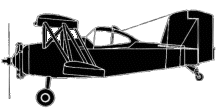
ASN Wikibase Occurrence # 289277
This information is added by users of ASN. Neither ASN nor the Flight Safety Foundation are responsible for the completeness or correctness of this information.
If you feel this information is incomplete or incorrect, you can submit corrected information.
| Date: | Saturday 28 May 2011 |
| Time: | 07:00 LT |
| Type: |  Grumman G-164A |
| Owner/operator: | Crop Jet Aviation LLC |
| Registration: | N9724 |
| MSN: | 1244 |
| Year of manufacture: | 1974 |
| Total airframe hrs: | 15789 hours |
| Engine model: | Pratt & Whitney R1340 S3H1G |
| Fatalities: | Fatalities: 0 / Occupants: 1 |
| Aircraft damage: | Substantial |
| Category: | Accident |
| Location: | Hazelton, Idaho -
 United States of America United States of America
|
| Phase: | Manoeuvring (airshow, firefighting, ag.ops.) |
| Nature: | Agricultural |
| Departure airport: | Hazelton, ID (U94) |
| Hazleton, ID | |
| Investigating agency: | NTSB |
| Confidence Rating: |
The pilot was completing an aerial application pass over a field when the engine began to lose power. He initiated a climb, heard a bang, and observed a white puff of smoke issuing from the top of the engine. The engine subsequently lost all power, and the airplane sustained substantial damage during a forced landing into a pasture. Postaccident examination of the engine revealed that it did not exhibit catastrophic internal damage or any preimpact anomalies that would have precluded normal operation. The carburetor was undamaged during the accident and was subsequently installed on an exemplar engine for testing. During the tests, the engine sputtered, backfired, hesitated, and produced puffs of white smoke from the exhaust ports when the throttle was advanced from idle to power. The sputtering stopped when the throttle was advanced slowly. Examination and disassembly of the carburetor revealed excessive wear, particularly to the accelerator pump assembly. The accelerator pump provides increased fuel flow to the engine during rapid throttle advance, and an ineffective pump would cause engine hesitation and stumbling during acceleration. The symptoms reported by the pilot during what would have been rapid engine acceleration after completing a pass was consistent with a worn accelerator pump, and matched the engine characteristics observed during the carburetor test. The carburetor had been installed on another engine since its most recent maintenance event and its total time since overhaul could not be determined. The engine examination also revealed that five teeth from an intermediate gear within the supercharger drivetrain were fractured, with loading opposite of the direction of rotation. Metallurgical tests found that the teeth failed in overload. Given the rotational speeds of the supercharger system, the gear failure was most likely caused by the sudden engine stoppage after the propeller made contact with the ground.
Probable Cause: A total loss of engine power during low-level maneuvering due to an excessively worn carburetor.
Accident investigation:
 |
|
Sources:
NTSB WPR11LA238
Location
Revision history:
| Date/time | Contributor | Updates |
|---|---|---|
| 05-Oct-2022 11:56 | ASN Update Bot | Added |
Corrections or additions? ... Edit this accident description
The Aviation Safety Network is an exclusive service provided by:


 ©2024 Flight Safety Foundation
©2024 Flight Safety Foundation